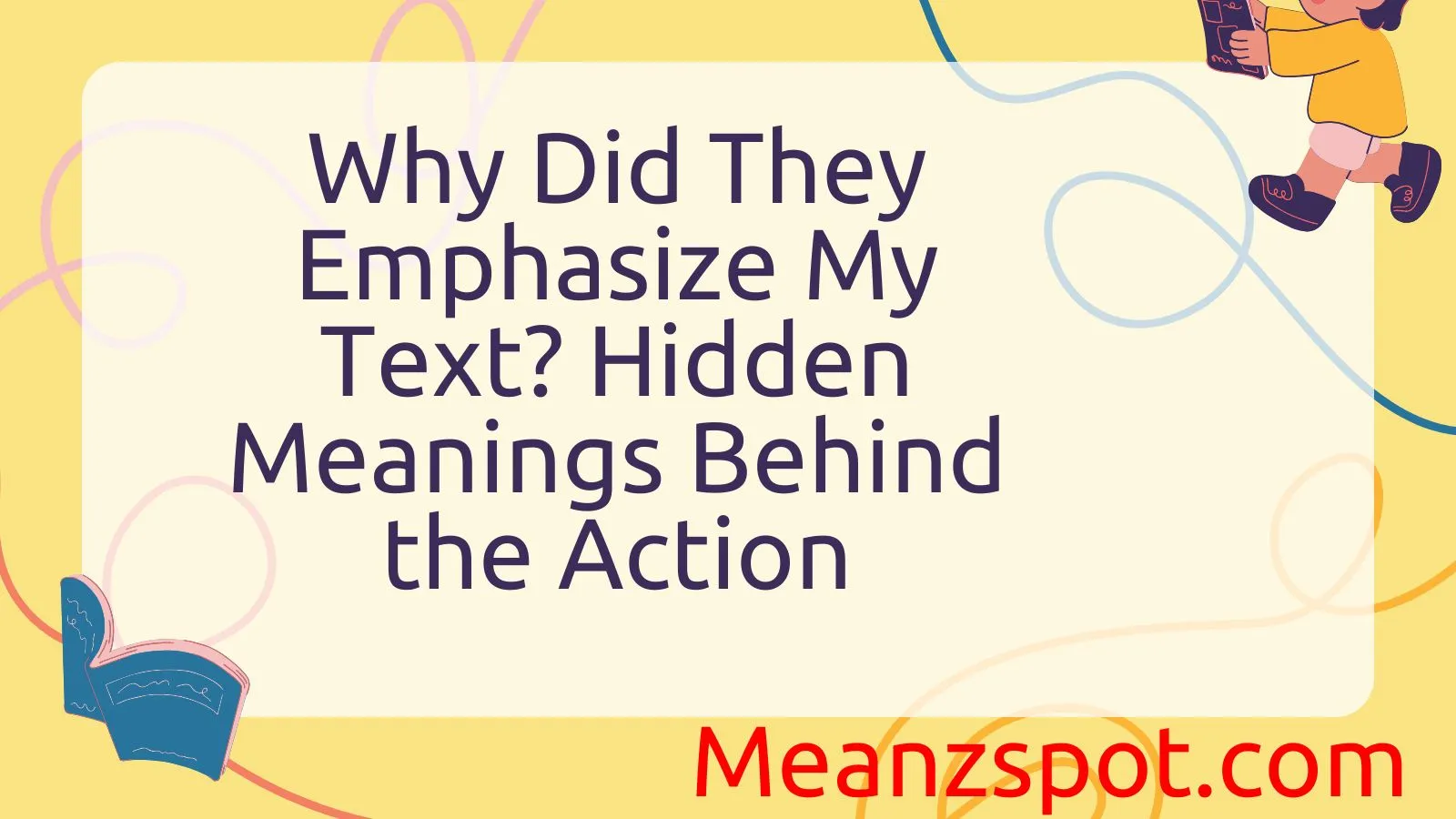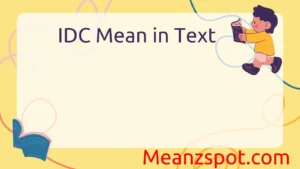In today’s world of instant messaging and digital reactions, communication goes far beyond just words. With platforms like iMessage offering features like “emphasize,” “like,” “laugh,” and “question” reactions, it’s natural to wonder what someone really means when they emphasize your message.
So, why did they emphasize your text instead of replying with actual words? Was it a quick nod of agreement, a way to highlight something important, or is there a deeper emotional cue behind that subtle tap? In a time where emojis and reactions speak louder than full replies, understanding these nonverbal signals is more important than ever.
Whether you’re texting a friend, coworker, crush, or family member, this updated guide will help you decode the hidden meaning behind text emphasis—so you never misread a vibe again. Let’s break it down.
Definitions & Meaning
When someone “emphasizes” your text, especially on platforms like iMessage, it usually means they have reacted to your message using a specific built-in reaction. On iMessage, for example, an emphasis is shown using two exclamation points (“!!”) attached to your original message. This reaction is one of several options, alongside “like,” “love,” “laugh,” “question,” and “dislike.”
What does “emphasize” typically mean?
- Highlighting importance: The sender wants to underline that your message is noteworthy or urgent.
- Showing strong agreement: They strongly agree or feel your message deserves attention.
- Conveying surprise or shock: The emphasis could also indicate astonishment or disbelief.
For instance, if you text someone, “I finally got the job!”, and they emphasize it, they may be expressing enthusiastic approval or excitement. However, context is everything. If you text, “We need to talk.” and get an emphasis response, it might indicate urgency or stress.
In summary, emphasizing a message is a non-verbal cue to draw attention to a statement, similar to underlining a sentence in a book or adding bold text in an email.
Origins & History
The ability to “emphasize” messages comes from the increasing reliance on non-verbal digital communication. Apple introduced iMessage Tapbacks in 2016 with the release of iOS 10. The feature was designed to allow users to quickly and subtly respond to texts without sending a full message back.
Why was it introduced?
- To streamline conversation.
- To add emotional nuance to text.
- To keep chats flowing even when full replies weren’t necessary.
Tapbacks were Apple’s answer to emoji reactions becoming popular on platforms like Facebook and Messenger. As communication shifted toward fast-paced messaging, users sought quicker, more expressive ways to react to conversations. This led to built-in reactions becoming standard features across many apps.
The exclamation point “emphasize” reaction was particularly unique because it wasn’t just about positive or negative sentiment—it was about intensity. It gave users a way to say, “This matters,” “Wow,” or “This is urgent,” without typing those words.
Over time, other platforms have developed similar features, though they may not use the same terminology. But the origin of the word “emphasize” as a reaction belongs largely to Apple’s iMessage ecosystem.
Usage in Different Contexts
1. Social Media Messaging
On platforms like Facebook Messenger or Instagram DMs, while the exact term “emphasize” isn’t used, similar functionality exists. Reactions like emojis can be used to show intense agreement, love, or laughter. These are often context-dependent, and while they may not say “emphasized,” they serve the same role.
Example:
A friend posts, “Finally booked my vacation!”
Reaction: 🔥 or ❤️ — akin to emphasizing the excitement or importance.
2. Professional Communication
In business or professional settings, the concept of emphasizing a message takes a slightly different form. While professionals may not use iMessage’s Tapback, tools like Slack, Microsoft Teams, or email clients use features like:
- Reactions (e.g., thumbs up, checkmark)
- Highlighting, bold text, or tagging
Here, emphasis often means a point is critical or needs attention.
Example in Slack:
“Reminder: Team meeting rescheduled to 3 PM.”
Reaction: ✅ — an acknowledgment that also signals the message is seen and important.
3. Pop Culture and Casual Chats
In casual messaging, particularly among younger users, emphasizing can be playful, ironic, or dramatic. It’s not always serious—it might even be used sarcastically.
Example:
“I just ate an entire pizza.”
Emphasized reaction: could mean, “Wow!” or “You’re confused (in a fun way).”
The usage often blends tone, context, and relationship. Friends who understand each other well can use these reactions in humorous or layered ways that outsiders might misinterpret.
Common Misunderstandings & Clarifications
Despite its utility, emphasizing a message can lead to confusion, especially among users unfamiliar with the feature or its intent.
Common misconceptions:
- “They’re mad at me.”
Some interpret emphasis as aggressive or upset, especially when placed on serious messages. - “They didn’t reply, so they must not care.”
People sometimes assume an emphasized reaction is lazy or dismissive. In reality, it could mean they agree so strongly that no more needs to be said. - “It’s the same as liking a message.”
Not quite. Liking usually signals approval or affection. Emphasizing implies urgency, importance, or enthusiasm.
Clarifications:
- Tone matters. If the original message was emotional or vague, the emphasis might be perceived differently.
- Know the sender. Interpret reactions based on your relationship with the person.
- Not a replacement for replies. In emotionally complex conversations, a reaction can seem dismissive if not accompanied by real words.
To reduce confusion, consider adding a short follow-up message when emphasis might be misread.
Alternatives & Synonyms
If you want to emphasize a message but aren’t using a platform with reaction features, there are many alternatives.
In Text Communication:
- Using punctuation:
“That’s incredible!!” - Capitalization:
“THIS is what I was waiting for!” - Asterisks or underscores:
“This is very important.”
Synonyms for “emphasize”:
- Highlight
- Stress
- Underscore
- Draw attention to
- Accentuate
- Point out
- Reinforce
These options are especially useful in formal or professional writing where emojis or reactions aren’t suitable.
Example in email:
“I want to underscore the importance of submitting the report by Friday.”
The way you emphasize something may differ based on audience, tone, and purpose.
Frequently Asked Questions
1. What does it mean when someone emphasizes a message on iMessage?
It typically means they strongly agree with or want to highlight the importance of what you said.
2. Is emphasizing a text the same as liking it?
No, emphasizing often conveys urgency or significance, while liking shows general approval or agreement.
3. Can emphasizing a message be seen as rude?
It depends on context. In emotional or serious discussions, it may seem dismissive if not followed up with words.
4. Why don’t I see emphasized reactions on Android?
Android users often receive reactions as texts (e.g., “John emphasized your message: ‘Be there soon.’”) due to platform differences.
5. What should I do if I’m unsure why someone emphasized my message?
Ask! A simple, “Hey, just checking—was that emphasis a good thing?” clears up confusion.
6. Is it okay to emphasize messages in professional settings?
Only if the platform supports it (e.g., Slack) and your workplace culture is open to informal reactions.
7. Can emphasizing replace a real reply?
Not always. While it works for short interactions, more complex conversations need full responses.
Conclusion
In today’s fast-paced digital world, features like the “emphasize” reaction offer a convenient, expressive way to interact without words. While small in appearance, this gesture can hold a variety of meanings—from enthusiasm and urgency to support and surprise. Understanding the context, tone, and platform helps interpret these reactions more accurately and reduces miscommunication.
Whether you’re navigating professional chats, casual conversations, or social media exchanges, knowing what it means when someone emphasizes your text empowers you to communicate better and respond appropriately. Next time you see those double exclamation marks, you’ll know exactly what they might be saying—without a single word typed.



